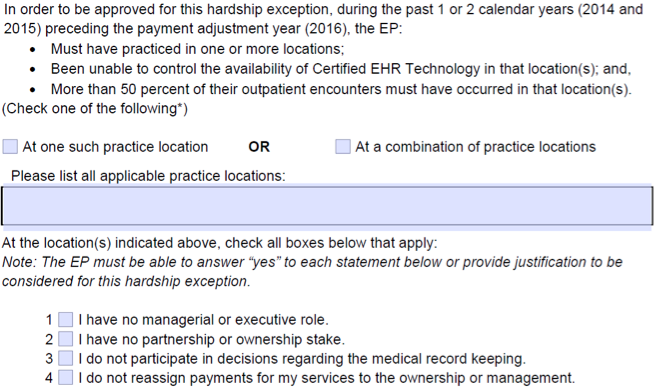 Well, folks, the summer solstice has passed and the days are becoming imperceptibly shorter. In Southside Virginia the dog days of summer are upon us, and it is hot, really hot. The month of July is right around the corner and with it the deadline for filing the meaningful use hardship exception. Every year about this time I field a number of queries about this issue. There is a lot of well-intended, yet inaccurate information out there, so today let’s clear up the confusion and set the record straight.
Well, folks, the summer solstice has passed and the days are becoming imperceptibly shorter. In Southside Virginia the dog days of summer are upon us, and it is hot, really hot. The month of July is right around the corner and with it the deadline for filing the meaningful use hardship exception. Every year about this time I field a number of queries about this issue. There is a lot of well-intended, yet inaccurate information out there, so today let’s clear up the confusion and set the record straight.
Why you should care
As you may recall, when the MU program began in 2011, there was not a penalty associated with non-participation. You either demonstrated MU and collected a check from CMS or you ignored the program or were ineligible to participate. When 2013 rolled around, non-participation in the MU program carried additional consequences beyond missing out on the payment for successful attestation. If you did not successfully attest in 2013, your Medicare Part B physician fee schedule was reduced by 1.0% in 2015—CMS created a non-participation penalty and levied it 2 years later.
The MU hardship exceptions were created because CMS recognized there are many circumstances in which providers have valid excuses for not demonstrating meaningful use, and in these settings they should not incur a penalty. The hardship process was first introduced for the 2013 reporting period. If you submitted a valid excuse prior to the CMS deadline, and that excuse was accepted by CMS, you were not subject to the 1.0% penalty that year.
The hardship application we are discussing today must be in the hands of CMS by 11:59 pm EDT, July 1, 2015. That time stamp reflects just how serious they are—late applications will not be reviewed. The application under discussion today reflects what you did (or could not do) during calendar year 2014, and it’s purpose is to avoid the 2.0% Medicare Part B penalty you would otherwise face in 2016 for failing to demonstrate MU in 2014. Clear as mud, right?
Hardship application not necessary
Before we get into the nitty gritty of the application itself, let’s make sure we understand who does NOT need to go through this application process. The set of instructions on the CMS web site is actually very informative.
First and foremost, if you successfully demonstrated MU in 2014, you can stop reading this post. Remember this hardship exception is for people with a valid excuse that explains why they did NOT demonstrate MU last year. If you did successfully demonstrate MU in 2014, you will not incur a penalty in 2016. There is no reason to file a hardship exception this year.
Second, if you are new to practice, which in this context means you did not file a Medicare claim prior to 2015 you do not need to file a hardship exception this year. CMS tells us you will not be penalized in 2016 based on the claims data they review.
Third, if more than 90% of your patient encounters occur in the hospital (defined as place of service codes 21 or 23 on the claims), CMS will classify you as a hospital-based provider and declare you ineligible for the MU program (and the penalty), so there is no need to file the hardship exception.
Last, but not least, while it’s unusual, some nephrology practices employ radiologists and some access centers employ anesthesiologists. If you have providers registered in PECOS as radiologists, anesthesiologists, or pathologists for that matter, you do not need to file the hardship exception. You are off the hook by virtue of your specialty.
The 50% Rule
There are four reasons for filing for a hardship application, but the only one I have been asked about is the one related to our old friend the 50% Rule. You remember that rule don’t you? It started as an eligibility requirement necessary to play in the meaningful use pond. Basically the 50% Rule states that if more than 50% of your outpatient encounters occur in a venue(s) of care not equipped with certified EHR technology (CEHRT), you are not eligible to participate in the program. Note I have highlighted “outpatient encounters.” Everything we do outside the hospital (place of service 21 or 23) is part of this calculation, including your face-to-face encounters in a dialysis facility or a vascular access center. The related hardship exception was created so that this provider group would not be penalized for non-participation.
The hardship exception related to the 50% Rule is labeled “Lack of Control over the Availability of Certified EHR Technology.” Effectively you are attesting to the fact that more than 50% of your outpatient encounters occurred in a venue(s) not equipped with a certified EHR AND the decision to deploy a certified EHR in those venue(s) is outside of your direct control.
One of the concerns I have heard raised goes something like this: “In 2013 I overcame the 50% hurdle because I accessed my office-based certified EHR from within the dialysis canter and entered the necessary patient data to meet meaningful use and I was paid the incentive for successfully attesting for MU. How can I now claim a hardship exception related to the 50% Rule?” Well, funny you should ask. If you have a chance, take a look at the top of page 30 in this transcript from a CMS-sponsored call explaining this specific hardship exception and its impact on nephrologists in dialysis facilities. The Cliff Notes version is this: we have the opportunity to continue to do that (access our office-based certified EHR in the dialysis center, capture the MU data, and use that data in combination with what happens in the office for our attestation). Or we can file for the hardship exception. Importantly each hardship exception is reviewed independent of what you did last year or the year before.
Nitty Gritty
So if you are still reading let me address a couple of points about the application itself, which are common sources of confusion. As noted above, the essence of this hardship exception is asking you to attest to two things: More than half of your outpatient encounters occurred in a venue(s) of care that was not equipped with a certified EHR AND the decision to deploy a certified EHR is beyond your direct control. If you are filing this application because of the 50% Rule, you must complete section 2.3. I have copied an important part of that section below:
Figure 1: Section 2.3 MU Hardship Exception Application
If you check all of the boxes labeled 1-4 in figure 1, there is no need to send in additional justification with your hardship application. Questions 1-4 are asked in order to establish whether or not you control the decision to deploy a certified EHR in these venues of care (dialysis facilities or vascular access centers). But many nephrologists are either medical directors, joint venture partners or both, and if that’s the case you would be wise not to check boxes 1 (medical directors) or 2 (JV partners). Instead, what’s more appropriate is to draft a note to include with your application (referred to in italics in figure 1 as provide justification to be considered for this hardship exception). In my view, and let me emphasize this is my view alone (which along with a couple of bucks will get you a cup of coffee), the justification that one might consider goes something like this:
- Medical directors do have a managerial role of sorts and are in fact responsible for medical oversight within the facility. Having said that, a dialysis facility medical director does NOT control the decision to deploy a certified EHR within the facility. You could certainly ask for a certified EHR, but at the end of the day it is the owner of the facility who controls that decision.
- Joint venture partners by definition have an ownership stake. But most JV partners I know have a minority equity position in the facility and typically the dialysis organization has the majority position. Again as a JV partner you could ask, but it is the majority partner that controls the decision to deploy a certified EHR within that facility.
If you step back and think about it, and I have thought about this more than I care to admit, this makes sense. Compare it with your office practice. Unless you are part of a large vertically integrated health system, you very likely control the decision to deploy CEHRT in the office. If you elect not to deploy, you cannot file this hardship exception because you do control the decision to deploy a certified EHR in your office-based medical practice. Next, consider the medical director of a nursing home, a venue of care that, like the dialysis facility is excluded from the meaningful use framework. If you are the medical director of a nursing home, you can jump up and down every day of the week, demanding the installation of a certified EHR, but the decision to deploy CEHRT remains in the hands of the owner of that nursing home.
By the way, before we finish this discussion, I should point out that there are dialysis facilities and vascular access centers that are utilizing certified EHR within their facilities. If you have encounters in such a facility, those encounters must be counted in the 50% calculus. You must include them with your office-based encounters as encounters in a venue of care with a certified EHR. In many cases, this hardship exception is off the table for nephrologists who find themselves in this position.
To file or not to file
As always, the decisions you make need to be the appropriate decisions for your specific circumstances. I offer the above as one perspective. The insights I share related to this topic come from years of exposure to the MU framework, broad reading on the topic, and countless conversations with a variety of folks in the industry. Of course after all of that, I could be wrong. But at the end of the day, the architects of this program did not have nephrologists in mind when they put the MU framework together, and they certainly were not thinking about our dialysis population and the unique interactions we have with those patients in a variety of outpatient venues.
Many nephrologists successfully filed for the 2015 hardship, and I suspect many more will do so before July 1 to appropriately avoid the 2016 penalty. There is plenty of sunshine in the days surrounding the summer solstice. How are you spending these long summer days? Are you planning to file a hardship exception? Drop us a note and join the conversation.
 Terry Ketchersid, MD, MBA, practiced nephrology for 15 years before spending the past seven years at Acumen focused on the Health IT needs of nephrologists. He currently holds the position of Chief Medical Officer for the Integrated Care Group at Fresenius Medical Care North America where he leverages his passion for Health IT to problem solve the coordination of care for the complex patient population served by the enterprise.
Terry Ketchersid, MD, MBA, practiced nephrology for 15 years before spending the past seven years at Acumen focused on the Health IT needs of nephrologists. He currently holds the position of Chief Medical Officer for the Integrated Care Group at Fresenius Medical Care North America where he leverages his passion for Health IT to problem solve the coordination of care for the complex patient population served by the enterprise.





RG says
Terry,
I loved the post. This mirrors what we just finished. We went ahead and sent them the data that shows we did more than 50 percent of the visits in the dialysis center. We also sent them a cover lever and for better or worse copied some of the blog articles to boot! I feel as though we received the benefits of M.U.—encouraged us to go electronic, received the bonus, etc….Additionally, we avoided all of the burdens by qualifying for the exception. I am glad you clarified why we can qualify one year and then not qualify during a different year—my office manager asked me that question too. Looking forward to catching up with you at the ASN meeting in SanDiego. Regards, RG
RG says
Terry,
Last night I received an email from CMS. It said “Your decision is now attached.” I anxiously opened the attachment. It said “Application not complete yet!” I did not know what to make of this. So we called and sent and email, but no one knows at CMS. Do you have any advice? Do you have a back office number we can call? Should we submit it again? THX.
Terry Ketchersid, MD, MBA, Chief Medical Officer - Integrated Care Group says
Well that’s interesting RG. I have not heard this one before. I am not aware of a number to call. I’d suggest closely reviewing the application you submitted and make certain all of the required questions were answered and that there were no “blank spaces” on the application. Regarding submitting it again, I have not read anything to suggest you cannot do that, and I do not see a downside. Please do keep us posted and let us know how it goes.
Kim says
Hi,
I have a quick qusetion in regards to the 50% rule. If we are able to attest to a 90 day period this year and a physician has a 90 day period throughout the year that they meet the 50% rule and can attest, but have several other 90 day periods that they could take the hardship for. Can we still take the hardship? Do we have to pick the 90 day period that the physician could attest based on the 50% rule? Hope this makes sense. Thanks
Terry Ketchersid, MD, MBA, Chief Medical Officer - Integrated Care Group says
Great question Kim. I have not actually seen this specifically addressed, but my sense is the provider does have flexibility in circumstances such as those you describe. At the end of the day you must be comfortable with the fact that your response, either attesting or filing the exception, is accurate as both are likely subject to audit. Also I notice you are describing activity for the 2015 calendar year. Note if you ultimately elect to file for an exception for 2015 (to avoid the 2017 penalty) you will need to wait until that application is available. That application will not be due until July 1, 2016.
Tammy says
Thanks so much for providing information on this topic. Do you suggest attaching reports to show the number of visits or is the letter sufficient. Our EHR reports all dialysis visits as one visit so additional documentation would also need to be attached to explain the difference in calculations.
Terry Ketchersid, MD, MBA, Chief Medical Officer - Integrated Care Group says
Tammy, I do not believe an accounting of visits is required as part of your supporting documentation. You are basically attesting to that fact more than half of your encounters occur in a location not equipped with a certified EHR.
Angel Squires says
We have an MD that works part time and ONLY sees patients in the dialysis unit. She was in practice with another group doing primary care but never filed MU. At this point, I don’t know what to do with this provider
Terry Ketchersid, MD, MBA, Chief Medical Officer - Integrated Care Group says
Angel, this provider is a great example of a physician for whom this hardship excpetion was created for and I would file the harship for this individual, otherwise they will face the 2% penalty for all of their Part B charges next year.
Jada Glanzman says
I have a physician that started with us on August 1st of 2014. Do we need to file a hardship exemption for hi?. I ran his reports for the last quarter and he did not meet the percentage for maintaining problem list. He had a 78% instead of the required 80%?????
Terry Ketchersid, MD, MBA, Chief Medical Officer - Integrated Care Group says
Jada, much depends upon where the provider was prior to Aug 1st. If they were in another practice and successfully demonstrated MU in 2014 with that practice, they should not be penalized in 2016. If on the other hand they are new to the practice of medicine (just out of training for example), as long as they attest prior to October 1 of 2015, they will not be penalized in 2016. Absent one of these two scenarios, they will be penalized in 2016 unless they successfully file for one of the hardship excpetions prior to July 1, 2015.
William says
Hi,
I have a question, I have been filing claims to Medicare for several years now under a bigger clinical setting, and then in September 2013, I became independent. We were only officially open a few months before the deadline came up in 2014. Unfortunately, the clinic I was working at before did not file meaningful use for me, and I wasn’t open long enough to have enough patients to report on. Am I eligible for hardship exemption?
Terry Ketchersid, MD, MBA, Chief Medical Officer - Integrated Care Group says
Great question William. Of note, eligibility for the program and the hardship are not dependent upon the number of claims you file in a given year. CMS basically looks for NPI/TIN pairs when they are counting. Your eligibility for the hardship that’s commonly used is based on the percentage of outpatient encounters that you have outside a venue of care equipped with a certified EHR. If more than half occurred in a venue of care not equipped with a certified record, AND you did not control the decision to deploy CEHRT in that venue of care, you are eligible to file for the hardship. Unfortunately the window to file for the work you did in 2013 (to avoid the penalty levied this year) closed on July 1, 2014. The window to file for the work you did in 2014 (to avoid the 2016 penalty) closed a couple of months ago on July 1, 2015.
Irene says
Our hospital did not meet MU in 2013 so they got a payment penalty in 2015 (10/01/14 – 09/30/15) but the hospital did meet MU in 2014 – will they not get a penalty in 2016 (10/1/15 – 09/10/16) or will they get payments reduced for 2016?
Terry says
The clock basically resets every year so if they were successful in 2014 the hospital should not incur a penalty in 2016.
sandeep says
I have many providers who see dialysis and office patients, I would like to know if we can count the 12 dialysis visits in a 90 day reporting period as one patient or if it is recorded as 12 encounters. 12 encounters increases the denominator much more and it appears then we would have to file for a hardship, however if we record that as 1 patient, then we would be able to pass the 50% rule.
Terry Ketchersid, MD, MBA, Chief Medical Officer - Integrated Care Group says
Great question Sandeep. We have been advised to count each face to face encounter within the dialysis facility as a single outpatient encounter. As you point out if the nephrologist sees his or her patients four times per month in the dialysis facility, this very quickly raises the outpatient encounter denominator. In fact, it is the principal reason nephrologists qualify for the hardship exception. If the dialysis information system is not ONC certified technology, then greater than 50% of the nephrologists outpatient encounters occur in a venue of care not equipped with CEHRT, and in most instances, the decision to deploy CEHRT in that venue of care is outside the nephrologist’s direct control. Thanks gain for your comment.
Donna says
I am very confused if you file a hardship do you still have to attest by the Feb. 28,17 deadline? If so why do you have to attest & file the hardship both; if you know you are going to file a hardship?
Terry Ketchersid, MD, MBA, Chief Medical Officer - Integrated Care Group says
Hello Donna,
You are in very good company as this is an confusing topic! Best to think about this in terms of the performance year. Last year (2016), your providers were required to either attest for Meaningful Use or submit a hardship exception. If you submitted a hardship exception and CMS granted the hardship, you do not need to attest for MU for 2016 (the last year for the MU program, and you will avoid the MU penalty in 2018. Moving forward, for performance year 2017, MU disappears and is replaced by the Advancing Care Information category of MIPS. If you file for the ACI hardship for 2017 and the hardship is granted by CMS, you will avoid reporting ACI, but the other MIPS catagories will be over weighted as a result.